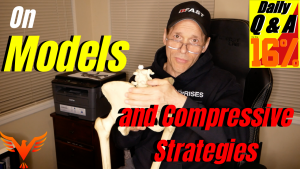I get a lot of questions as to how I interpret table tests, and how I relate the results of them to representations of the archetypes, symmetry or asymmetry, and what interventions are best. Your chessboard (the compilation of all your table measures) produces a 4D representation of your client in space. This guides your […]
Breathing exercises
Q & A for The 16% – Elbow Pain with Low Bar Back Squat Explained – Knee Position with Lunges
Grab your @neurocoffee or maybe a margarita for today’s Q & A! From Mike: What causes elbow pain when unpacking the bar in a low bar back squat? What can I do about it? From Mike (a different Mike): What causes the back knee to deviate outward when trying to perform a lunge or a […]
Q & A for The 16% – Pump Handle Mechanics for Shoulder Internal Rotation and The Golf Swing
I’ve got my @neurocoffee, so here’s today’s Q & A. From Sarah: I’m have been putting forth a lot of effort to catch up and stay up with all of your content now that I have a little more time on my hands. I wanted to reach out with a couple questions/clarifications. Strategies for working on […]
Q & A for The 16% – Overcoming the Limitation of Your Model of Movement
I’ve my @neurocoffee, hope you have yours. Here’s today’s Q & A. From Carmine: I appreciate the content you’ve continued to put out during these times. I have a question in regard to your model. George Box said “All models are wrong, some are useful.” What would you say are the limitations of your model? […]
Q & A for The 16% – Understanding Models and Compressive Strategies that Limit Movement
Grab your @neurocoffee for today’s Q&A. From Rachel: I’m having a hard time conceptualizing anterior/posterior compression. If an individual shows a posterior to anterior compressive strategy, they will lose ER of appendages. In my mind, if someone is compressing posteriorly, wouldn’t muscles (say, glute max, piriformis, traps) be concentrically oriented, wouldn’t this lead to gains of […]




